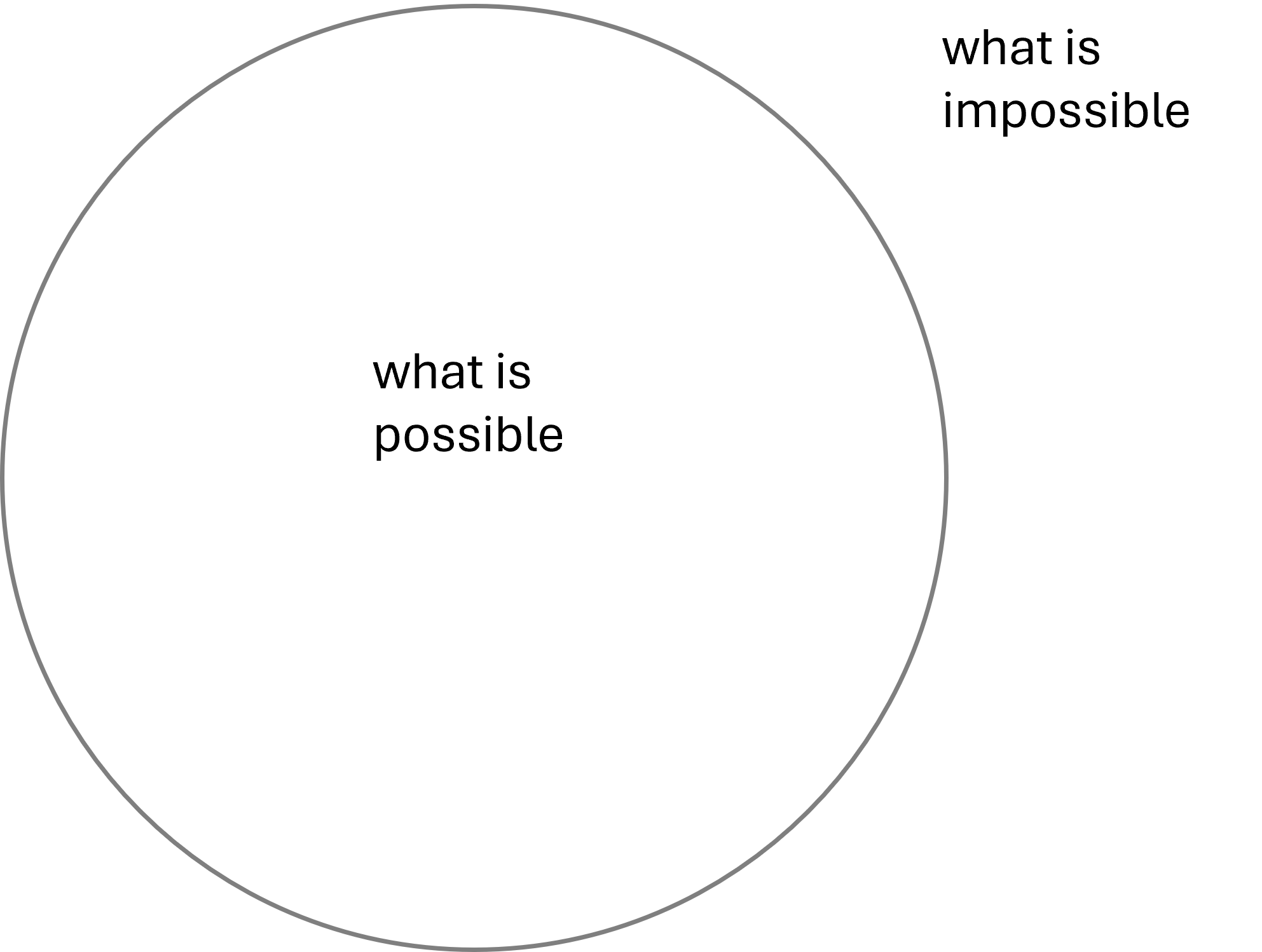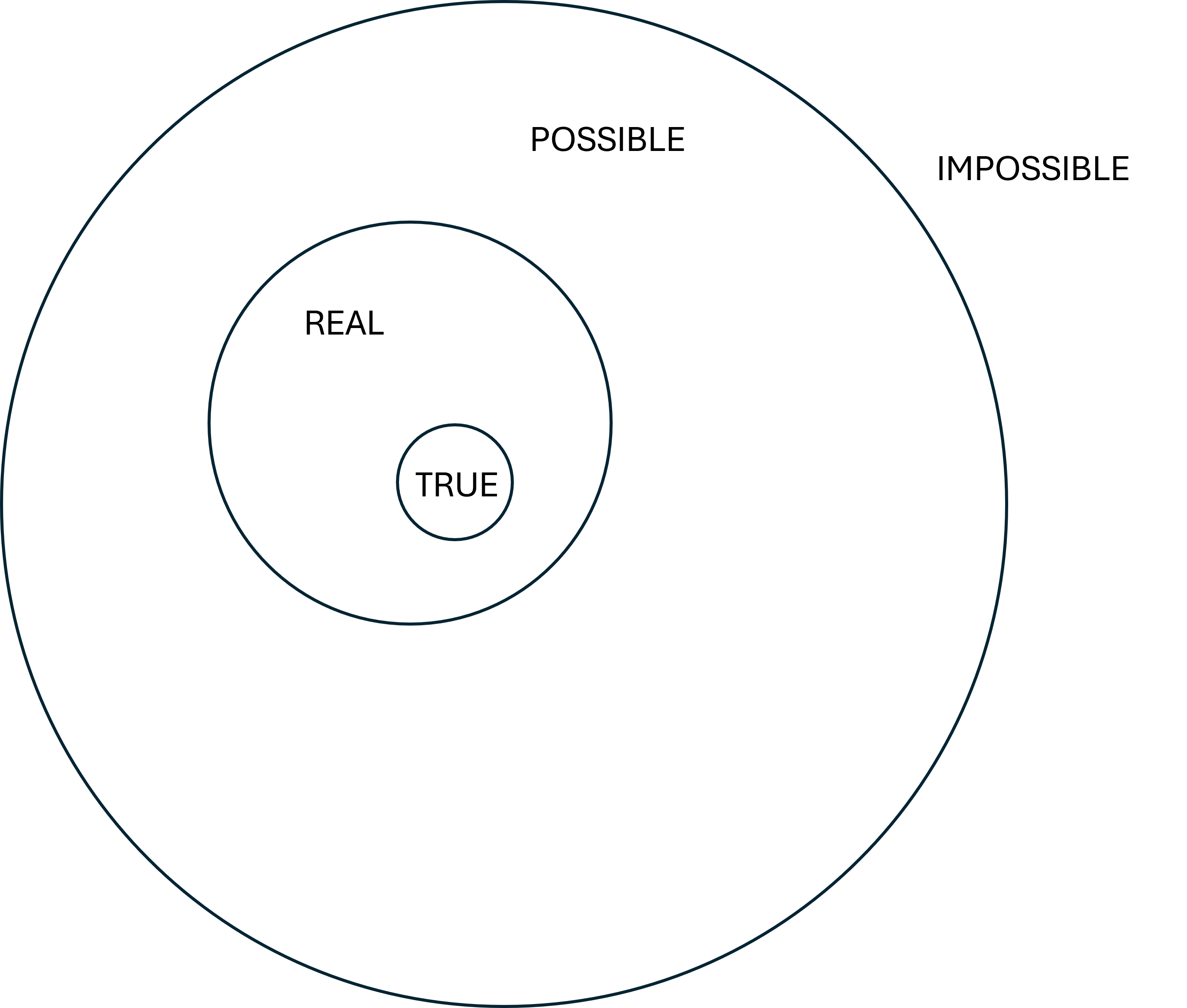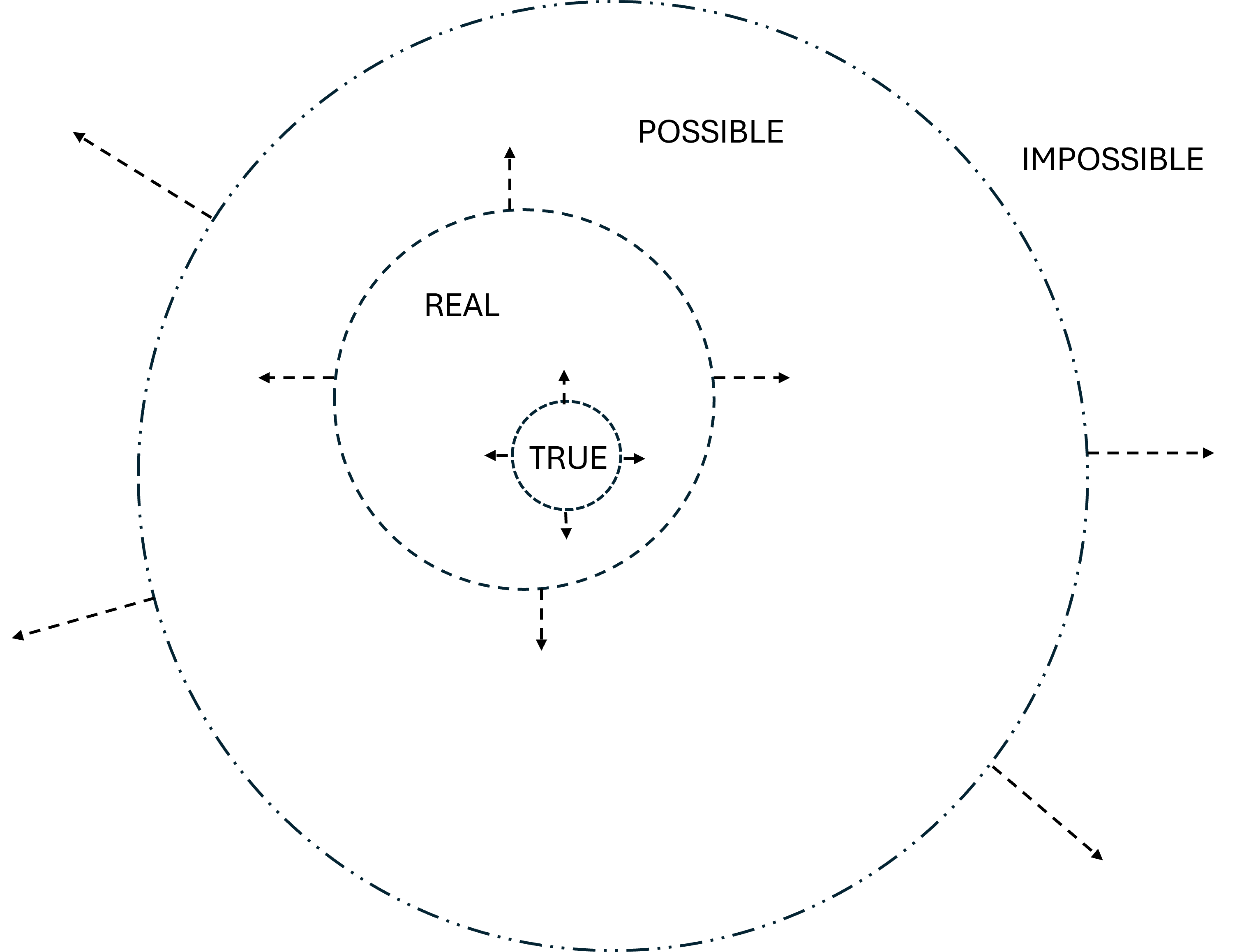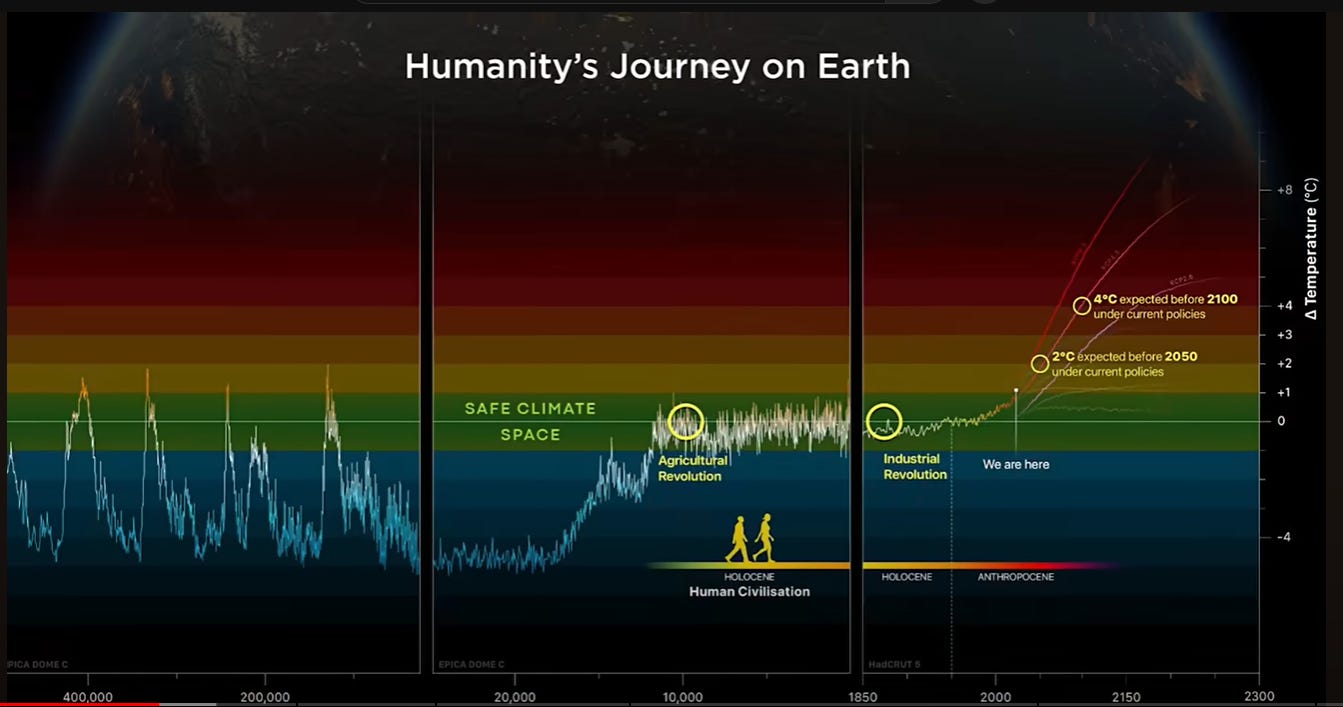We ended the last session of the previous course with an exercise:
- Draw a circle that represents what is possible. By definition, what is outside that circle is impossible. Like this:

-
Now, draw one circle that represents “what is real” --- making its placement and size specifically to illustrate the relationships.
-
Finally, draw another circle that represents “what is true” --- again paying attention to its placement and size in order to correctly illustrate how you see the relationships between all the categories.
What did you discover?
Pragmatic Imagination begins when you discover that the True is atiny subset of the Real, and the Real is a tiny subset of the Possible. Like this:

Furthermore, it is important to see that what is True, what is Real, and what is Possible continuously advance into novel spaces.

Consider elephants, for example. As a category, they are possible; as concrete indiviuals they are real; and we can specify somethings (but not everything) about them that are true. There was a time before, when the elephants were possible, but not real. There may be a time when we still can say something true about elephants, but it may not be possible for any real elephants to exist anymore. Now consider a certain gut bacterium that only lives inside the elephant digestive system. Before there were elephants, that bacterium was not possible in any real sense, because it’s own possibility dependent on something that was not yet real. There is a relation of retroactive causality here. The existence of the elephant retroactively sets the (never before) possibility of the bacterium, back in the distant past. (In other words, it makes no sense to think that a certain bacteria living in a completely imaginary animal is somehow “possible.“) Once the causal relations are closed, we can specify a true fact about the bacteria.
The authors (AJP-JSB) of this two volume book Design Unbound, of which the final section was made into a small pre-print called Pragmatic Imagination --- argue that we are entering a period wherein evolution is becoming less punctuated --- periods of change followed by long periods of stability --- and more continuous, and accelerated. This means we should anticpate the boundaries of the possible to become porous in front of our very own eyes. In volume 1 of their book, subtitled Designing for Emergence, AJP-JSB highlight the TIM+N framework as a theory of change.
David Ronfeldt distinguished between four forms of societal organization based on different modes, scales and rates of interconnectivity, and commuication:
Tribes (T) are kinship-based social units, sturctured as extended families, clans, and other lineage systems. Tribes reliy on oral communication , especially stroytelling, for their cohersion, and therfore, depend upon proximity of individuals
Institutions (I) are hierarchical in nature, and are exemplified by the church, army, or beraucratic state. Institutional form relies on the transcribing of oral communication into writing that can be disseminated to larger groups as books, records and commands. At first handwritten, the printing press scales the capacity to produce documents around which institutions formed and operated.
Markets (M) are aout competitive exchange; merchants and traders, responding to forces of supply and demand, rely on interconnectivity and mobility provided by infrastructure.
And finally, networks (N) are wel-like ties that rely on digital hyperconnectivity across time and space.
Ronfeldt emphasized that each prior form must be rebalanced and integrated into the new form which includes the healthy functioning of all forms; such that, we live not in an N-era, but a TIM+N one. Still during the transition phase, we should expect the feeling of precarity, and philosophical, ideological and material struggles. In other words, we should expect a struggle around Who Gets to Build the World We Will Live In?
AJP-JSB offer a revised version of Ronfeldt’s framework. They propose that the network effect is not just another add-on, but it is an exponential factor. That we live in a “TIM to the power of N” world, which they characterize as “a white-water-world.”
This first book is an exploration of what modes of human activity are themselves best designed to move in this world, with this level of complexity and speed? What skills do we need to, as they phase it “orchestrate ambiguity?” The answer they work towards is “pragmatic imagination.” Let’s see how they get there, moving from stepping stone to stepping stone along the way.
Prefiguring a Prefiguring World
Human existence has been predicated on the relatively stable geological era called the Holocene. Today, and increasingly, this is not the case. The very earth systems that have provided the necessary conditions for human flourishing are breaking apart.

The ways in which we interact with the earth’s systems --- climate, land use, pollution, toxicity, ecological destruction, large scale agriculture and animal farms --- has a devastating feedback loop with the natural systems of the earth. Our actions have reached destructive influences at planetary scales, threatening the conditions for our own existence.
After a century of unparalleled scientific and technological progress we have made our presence known to the planet in the most dramatic and self-defeating fashion. … We are faced with a very different kind of feedback: a bewilderingly complex array of interrelated and unpredictably erratic fluctuations over which we have little or no control and which remind us that the whole world is a giant ecosystem with a sensitive biosphere that has taken 4.5 billion years to evolve. ~ Guattari
Every ecological register constitutes its own sphere of values. We belong to the material register as much as the social and the informational--- but the material is fundamental to the existence of the social, in the same way that the informational could not be possible without a social ecology. Today, we mostly ignore the values inherent in the biosphere, which includes the material and geological earth. Today, we grossly underestimate the consequences of this. Ecological and material trends are strongly coupled to social, governmental, and demographic ones:

These risk vectors have been shifting, undermining what we belive about our world today. National borders and powers have shifted dramatically from the US-dominance that emerged from the Bretton-Woods Accords after WWII, to situations that are largely and increasingly ambiguous today. Interactions in such as world are nonlinear and disproportionate--- minor actions can result in major consequences.
An historical era is said to be “prefigured” when the seeds of what will emerge are already operating in that period, but often beneath awareness. We can see, for example, how certain advances in technology in the 1970’s “prefigured” the internet and the digital age of the 2000’s. What the authors are ostensibly calling forth is a way to “prefigure” worlds in a historical period that is screams itself to be prefiguring new worlds. Their response is called “pragmatic imagination” , which they admit is a paradoxical concept, since it “is after real-world impact” but it is meant to compell people, individually and collectively to “think and live differently.” The power of Pragmatic Imagination lies in the ability to release the imagination (unbind it from existing constraints) while recognizing that its fruits dcan only grow from seeds sown in real-world soils.
In thinking from the perspective of material, social, and mental ecologies,
it is a whole new game. The third window not only provides a new way to frame the world, but also a new role for the imagination--- an imagination engangled with action and put to purpose.
Six Principles
At the end of their work, the authors Ann Pendleton-Julian and John Seeley Brown (APJ-JSB) identify six principles for pragmatic imagination:
1. The imagination serves diverse cognitive processes as an entire spectrum of activity. (This is not a polarization of reasoning versus imagination.)
2. There is always a gap between what we actually experience and the cultural lens through which we interpret that experience. Imagination helps resolve the gap, but the gap must first be revealed for what it is — a mistmatch between reality and conventional sensemaking norms.
Somewhere at the edge of abductive reasoning where it blends into the domain of the speculative imagination, the imagination’s functioning shifts from sense-making to sense-breaking in order to generate novel content for consideration. It widens the gap to disrupt normative thought processes and practices. It is then also employed alongside reasoning to close the widened gap so that novel content can be assimilated.
3. The Pragmatic Imagination pro-actively imagines the actual in light of meaningful purposeful possibilities and sees the opportunity in everything.
The actual must always be seen in light of the possible.
4. The Pragmatic Imagination sees thought and action as indivisible and reciprocal. Therefore it is a part of all cognitive activity that serves thought and action for anticipating, and thought and action for follow-through. And the generative/poietic/sometimes-disruptive side of the spectrum is especially critical in a world that requires radically new visions and actions.
The imagination must be instrumentalized to turn ideas into action.
5. The imagination must be instrumentalized to turn ideas into action— the entire spectrum of the imagination especially the generative/poietic/sometimes-disruptive side.
6. Because the imagination is not under conscious control, we need to understand, find, and design ways to set it in motion and scaffold it throughout meaningful activity.
Cohorts
Note that access requires a paid membership.